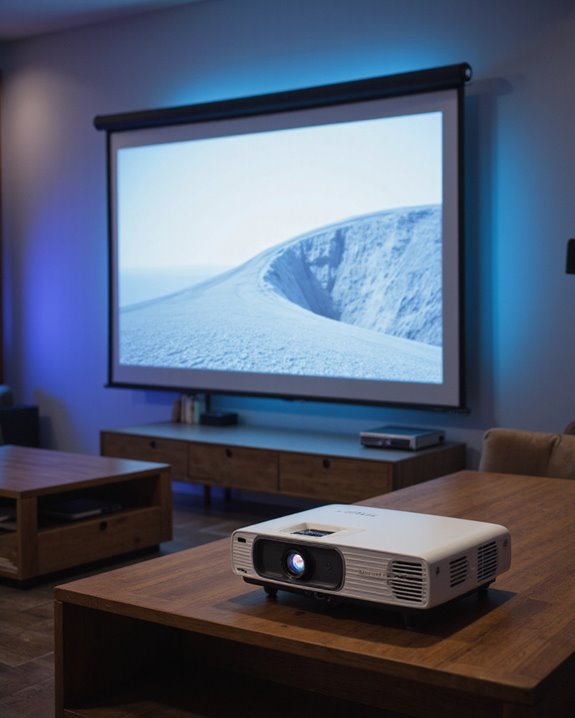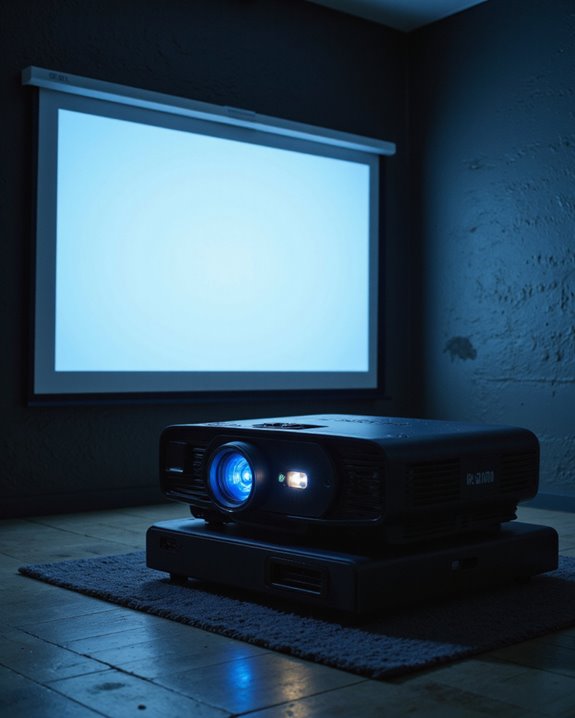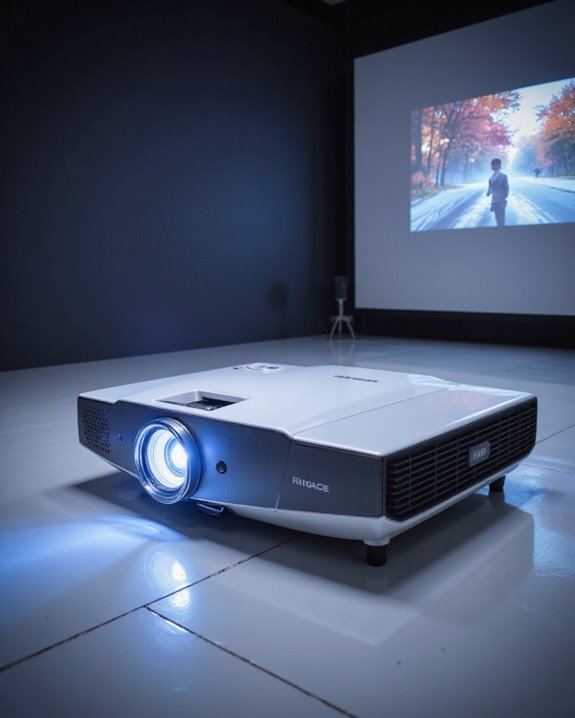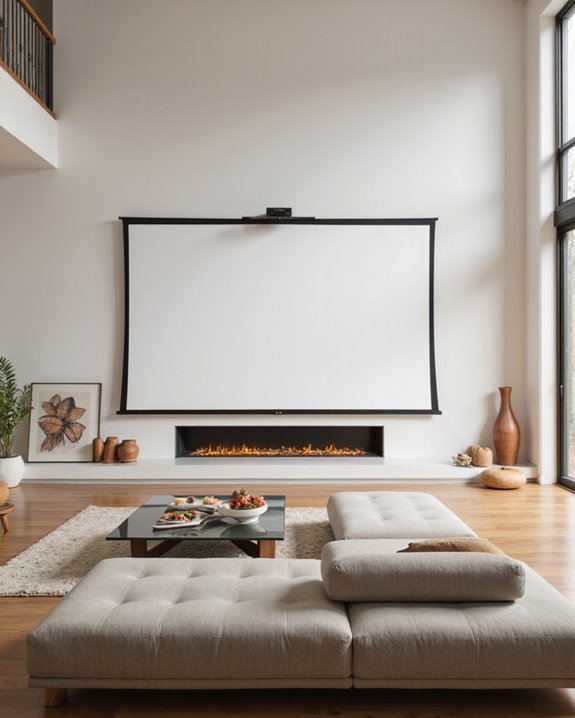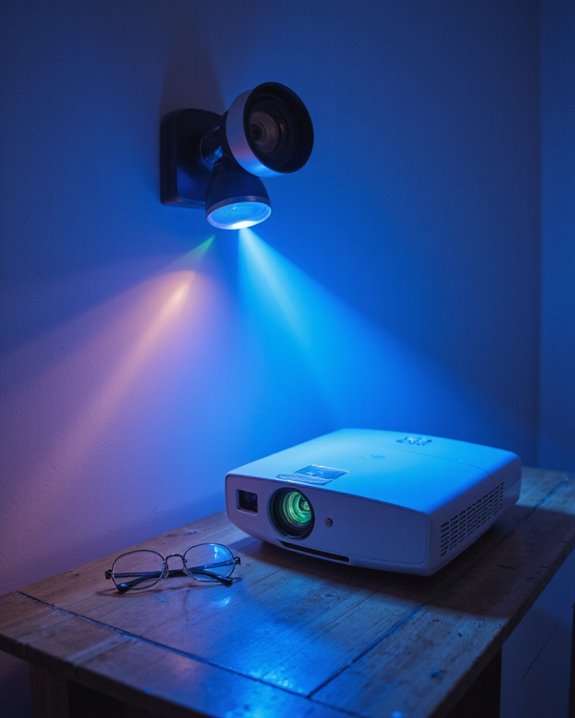Modern projectors have seen remarkable improvements across multiple areas. Ultra-short-throw technology now produces large 100-inch images from just inches away, while brightness levels reach up to 5,000 lumens for clear viewing in lit rooms. Smart features include built-in streaming apps, voice control, and wireless connectivity. Advanced laser technology delivers vibrant colors with 20,000-hour lifespans, and sophisticated audio systems offer immersive sound experiences. These innovations mark just the beginning of projection technology’s evolution.
Key Takeaways
- Ultra-short-throw technology now delivers 100-inch images from inches away, revolutionizing space efficiency and installation flexibility.
- Advanced laser light sources provide superior brightness up to 5,000 lumens and extended lifespans of 20,000 hours.
- Smart features integrate streaming apps, voice control, and wireless connectivity, eliminating the need for external devices.
- Modern audio solutions incorporate Dolby Atmos and AI-powered room calibration for immersive, optimized sound experiences.
- Portable projectors have become significantly smaller, with some models matching smartphone sizes while maintaining high-quality display capabilities.
The Revolution of Ultra-Short-Throw Technology
Ultra-short-throw projector technology has revolutionized home entertainment and professional presentations by offering a solution to space constraints that traditionally limited projector installations. Through sophisticated lens innovation, these projectors can create large images up to 100 inches from just inches away from the wall, transforming how people experience visual content in small spaces. The technology employs advanced optical systems and mirrors to bend light precisely, enabling shadow reduction while maintaining image quality. Modern ultra-short-throw projectors integrate laser light sources, which produce brighter images and offer extended lifespans of approximately 20,000 hours. Leading models like the EpiqVision Ultra LS650 now deliver 3,600 lumens of brightness for superior performance in well-lit environments. These projectors deliver superior performance even in well-lit rooms, thanks to enhanced brightness levels and compatibility with ambient light-rejecting (ALR) screens. The built-in audio capabilities, including support for formats like Dolby Atmos, complete the immersive viewing experience. Additionally, the integration of laser light sources provides consistent brightness and color accuracy over time, ensuring long-term reliability and vivid visuals.
Smart Features Transforming Home Entertainment
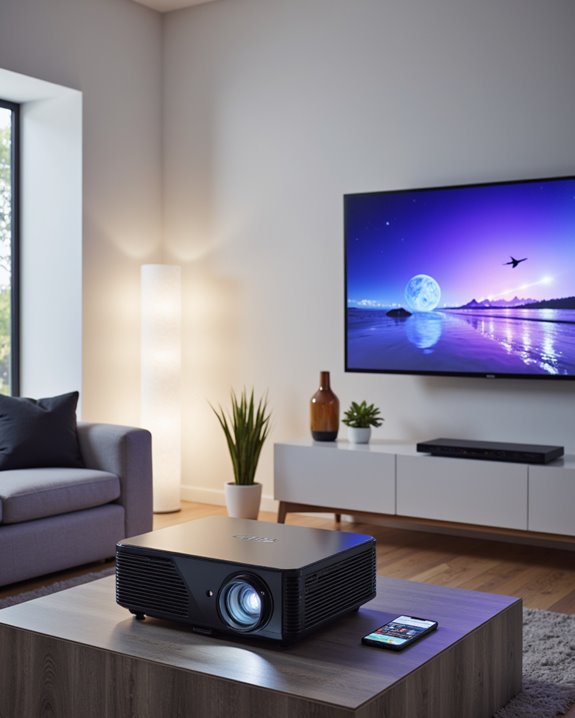
How have smart features revolutionized modern projectors? Today’s projectors integrate sophisticated interactive interfaces that transform them into complete entertainment hubs. Built-in streaming apps eliminate the need for external devices, while voice control capabilities allow seamless operation through popular assistants like Alexa and Google Assistant.
The latest models like the Hisense L5H come with Google TV integration for an enhanced streaming experience. These smart projectors now offer enhanced convenience through wireless connectivity, connecting effortlessly to smartphones and home automation systems. Features like auto-focus and automated keystone correction simplify setup, while built-in speakers with Dolby support deliver immersive audio experiences. Multi-device control allows users to manage their entire entertainment system through a single interface.
The integration of gaming support, smart remotes, and regular software updates ensures these projectors remain current with the latest technology trends, marking a significant evolution in home entertainment solutions.
Brightness and Display Quality Leaps

While smart features enhance user experience, the most dramatic advancements in projector technology center on brightness and display quality. Modern projectors now achieve unprecedented brightness levels, with many units delivering 4,000 to 5,000 lumens or higher, making them effective even in well-lit rooms. Color accuracy has also seen remarkable improvement through laser phosphor technology, which produces more vibrant and true-to-life images than traditional lamp-based systems.
Resolution enhancement continues to push boundaries, with 4K becoming increasingly standard. The shift to laser and LED light sources has enabled these improvements while offering additional benefits: longer lifespans, reduced maintenance, and better energy efficiency. These technological leaps are particularly evident in models like Epson’s EB-1985WU, which combines 4,900 lumens with WUXGA resolution for superior image quality. The high-brightness segment showing 10000 lumens and above is experiencing significant growth, especially in large venues like auditoriums and stadiums.
Modern Audio Solutions in Projection Systems
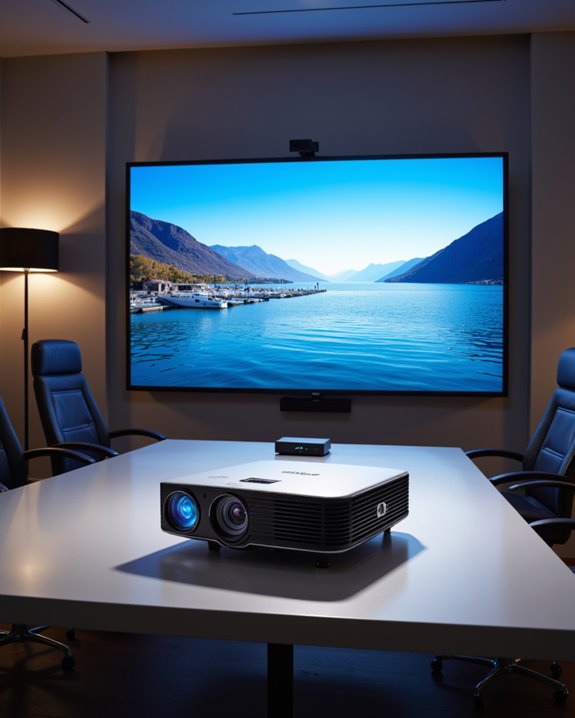
Modern projector systems have revolutionized audio capabilities through sophisticated sound technologies and smart integration features. These advances include immersive audio formats like Dolby Atmos and DTS:X, which create three-dimensional soundscapes with precise object placement and overhead effects. Following the success of products like the Magic Lantern in early projection history, modern systems have evolved to deliver superior audiovisual experiences. Additionally, the incorporation of wireless connectivity has made system setup more flexible and streamlined, allowing users to connect speakers and receivers without physical cables. AI-powered room calibration automatically adjusts audio settings based on the space’s acoustics, while voice control features enable hands-free operation through virtual assistants. Multi-device compatibility ensures seamless connection with various entertainment components, creating a thorough home theater experience. Future developments point toward enhanced AI-driven audio optimization and deeper integration with virtual reality experiences, suggesting continued evolution in projector audio capabilities.
Portable and Space-Efficient Design Innovations
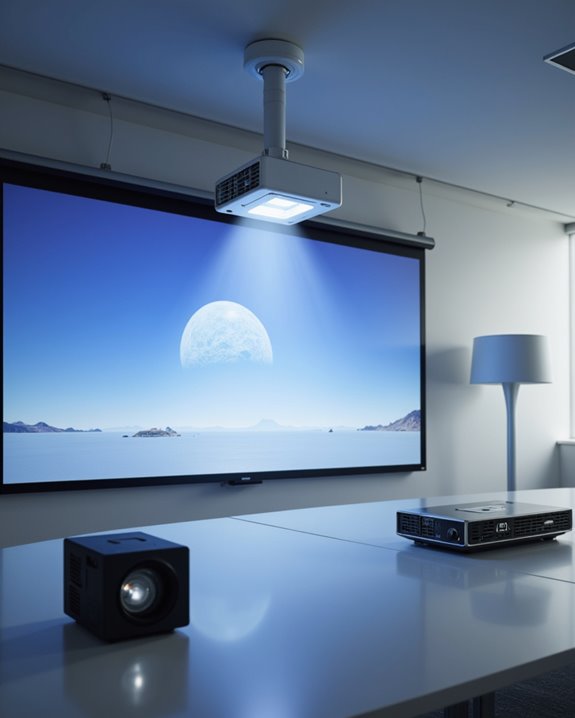
Recent breakthroughs in portable projector design have transformed traditional bulky devices into ultra-compact entertainment solutions. Modern projectors now feature innovative foldable stands and magnetic accessories that enhance their versatility while maintaining minimal footprint. Models like the Aurzen ZIP demonstrate remarkable space efficiency, with thickness comparable to a quarter and weight similar to a smartphone.
These compact projectors incorporate advanced features such as WiFi-free screen mirroring and ToF senseless focus technology, ensuring high-quality viewing experiences in various environments. The integration of tri-fold mechanisms and adjustable hinges allows for precise positioning without external supports. Popular models like the TCL A1 feature a unique 90-degree orientation design for enhanced installation flexibility. Manufacturers continue to improve battery life and portability through lightweight materials and streamlined designs, making these devices increasingly practical for both business presentations and outdoor entertainment activities.
Frequently Asked Questions
How Long Do Modern Laser Projectors Typically Last Before Needing Replacement?
Like a marathon runner outlasting sprinters, modern laser projectors far exceed traditional lamp lifespan, typically operating 20,000 to 50,000 hours. With laser durability and proper maintenance, they can function up to 12 years.
Can Projectors Be Used Effectively for Daytime Gaming Without Blackout Curtains?
Modern projectors with 3,000+ lumens can function during daytime, though ambient lighting affects image quality. High screen brightness is essential, and ideal results still benefit from some light control measures for better visibility.
What Maintenance Is Required for Keeping a Projector in Optimal Condition?
Regular maintenance includes lamp replacement according to manufacturer guidelines, filter cleaning to prevent dust buildup, lens cleaning with appropriate tools, and ensuring proper ventilation. Routine inspections help identify potential issues before they worsen.
How Does Projector Power Consumption Compare to Traditional Large-Screen TVS?
While projectors use 150-800 watts per hour, they offer better energy efficiency for large displays compared to TVs. A 90-inch TV consumes 381 watts, whereas modern laser projectors can achieve similar screen sizes using 120-381 watts.
Are Projectors Suitable for Outdoor Movie Nights in Varying Weather Conditions?
Modern projectors require specific weatherproofing features for outdoor use. While their portability is advantageous, most standard projectors aren’t weather-resistant. IPX-rated models or dedicated outdoor TVs offer better protection against varying weather conditions.

